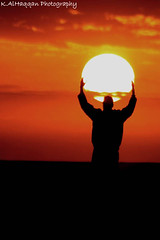Brushing Up on the Sunny 16 Rule
With digital cameras today, there's almost never a need to “guess” or estimate exposure settings. Even so, you may eventually find yourself having to ignore your light meter and take the situation into your own hands. Or perhaps you'll end up falling for film and buying an old camera without a light meter. Either way, having the ability to set exposure without the assistance of a meter is a good skill to acquire.
USING THE SUNNY 16 RULE
- Gauge Your Light
For the Sunny 16 Rule to work, you'll first need a sunny day. The rule can also work with other lighting situations such as cloudy and overcast — take a look at the next list for those. - Set Your F-Number
Set your f-number to f/16. If you don't have strong sunlight, use the next list to determine your starting f-number. - Set Your Shutter Speed
Take note of your ISO or film speed (let's call it “X”). Now set your shutter speed to 1/X. So at ISO 400, you'd use a shutter speed of 1/400 seconds. - Adjust With Reciprocals
You may want to use different shutter speeds or f-numbers. You can adjust one as long as you adjust the other accordingly. Opening up by one full f-number requires cutting your shutter speed in half (and visa versa).
VARIATIONS ON SUNNY 16
- f/16 for Sunny
- f/11 for Slight Overcast
- f/8 for Overcast
- f/5.6 for Heavy Overcast
- f/4 for Sunset
F-STOP GUIDE
Since most cameras offer full stops, half stops, and third stops, you'll need to have a handle on which ones are full stops so you can use the rule of reciprocals to change your f-number and shutter speed. Here's a list of full f-stops.
f/1 – f/1.4 – f/2 – f/2.8 – f/4 – f/5.6 – f/8 – f/11 – f/16 – f/22 – f/32 – f/45
But you don't need to memorize these numbers — there's an easy little trick to them. You actually just need to remember two numbers: 1 and 1.4. These are the first two full stops in the list. Double them and you get the next two in the list. Double those and you get the next two numbers. Check it out:
1.0 – 2.0 – 4.0 – 8.0 – 16 – 32
— 1.4 – 2.8 – 5.6 – 11 – 22 – 45
You'll notice that twice 5.6 isn't exactly 11 and twice 22 isn't 45. This is because the bigger numbers are rounded and the starting number isn't exactly 1.4 — it's 1.41421356… or the square root of 2.
Further Reading
Here are some additional resources having to do with Sunny 16 Rule and exposure.
- Sunny 16 Rule on Wikipedia
- Sunny 16 Rule on Camera Review
- Understanding Exposure on Luminous Landscape
- Exposure Demostrated on DIYPhotography.net
- Exposure and Stops on dPS
The rule really works — if you don't believe it, go try it out with any camera that has manual controls. I've been using the rule with my 1956 Minolta Autocord Twin Lens Reflex (no light meter) and it performs flawlessly.

Lisette
June 18, 2008Hi there.. Hope you don’t mind, I linked to this post… I think its great info for photographers just getting started, and for those who wouldn’t mind a refresher 🙂
the_wolf_brigade
June 18, 2008I’ve always wondered about the stops/full stops on film gear (but never bothered to find out). Using each setting as a stop has worked for me so far, granted on negative film. I think if you were going to use the sunny 16 on slide you’d need to pay attention to the actual “stops”.
You’ve taught me something new. It’s a good feeling, learning. 😀
Brian Auer
June 18, 2008Yeah, I’ve noticed that most of the old film cameras I’ve seen have the full stops marked and numbered even if you can select positions between them. Then there’s my Autocord… no notches or clicks, just numbers on a wheel.
the_wolf_brigade
June 18, 2008Just like the Rollei 🙂
Do you think that setting the dial between 50 and 100 gives a shutter speed of about 1/75? I should look at the manual. Though again, I guess with negative film it wouldn’t make that much of a difference.
Brian Auer
June 18, 2008I’ve contemplated the same thing about the shutter speeds and f-numbers on that camera. I suppose it would fire off at whatever value, but I have no real way of testing it.
Jeff Revell
June 21, 2008Hi Brian,
You beat me to the punch on the Sunny 16 post. I had a reader ask me about it in one of my posts after I talked about someone on of my photowalks who used the exposure method for his Graflex camera. You certainly covered the rule with great detail. Keep up the nice work.
Jeff
Randall Terada
August 9, 2008Thks! I was looking for this rule I once had heard of. Now I can play with my FED2. A friend bought for me in st Petersburg. The FED is a total mechanic range finder from the 60s USSR.
the_wolf_brigade
August 9, 2008@Randall Terada Love those Russian beauties. Built like tanks. I’ve yet to pick one up though…